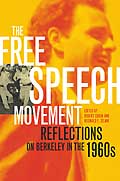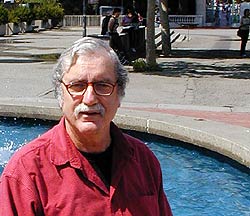|

|

|
NEWS SEARCH
|
|
|
|

|
Fresh,
behind-the-scenes look at Free Speech Movement in new book by
UC Berkeley, NYU professors
12 August 2002
By Janet Gilmore, Media Relations
Berkeley - It's been nearly 40 years since the Free Speech
Movement exploded onto the University of California, Berkeley,
campus, changing the political atmosphere at colleges and
universities across the country and providing generations
to come with a model for student activism. Yet, few scholars
or veterans of the movement have fully explored its origins,
development and legacy.

|
|
Two history professors hope their new book, "The Free Speech
Movement: Reflections on Berkeley in the 1960s," (University
of California Press) will give readers a fuller, more complex
view.
The book, to be released to the general public in early
October, is a compendium of new articles and memoirs, largely
by Free Speech Movement veterans and UC Berkeley faculty
members. It includes several essays by scholars who pored
over previously unavailable research materials, offering
new insights into the movement and fresh analyses of issues
of the day. Much of this primary material is located in
the Free Speech Movement collection of The Bancroft Library
at UC Berkeley.
"I hope the book helps people understand that a movement's
slogans are never a substitute for careful analysis of the
historical events," said UC Berkeley history professor Reginald
Zelnik, co-editor of the book.
Zelnik's co-editor, New York University associate professor
Robert Cohen, spoke similarly: "I want people to see how
complex the '60s were, to create a peeling away of some
of the ridiculous stereotypes about '60s activists as wide-eyed
revolutionaries trying to burn down the library."
| |

Reginald Zelnik on Sproul Plaza, where the Free Speech Movement ignited in 1964. (Bonnie Powell photo) |
During the Free Speech Movement of 1964, a time when the phrase
"Don't trust anyone over 30" was popular, Zelnik was a 28-year-old
junior faculty member at UC Berkeley. In an essay he wrote
for the book - part memoir, part research paper - Zelnik explained
the complicated, yet essential role that certain faculty members,
the vast majority of whom were over 40, played in critically
supporting the movement and challenging the administration.
His essay also carefully documents why this support occurred,
and places into context the obstacles to mobilizing faculty
assistance during the first two months of the movement.
Cohen, author of three of the book's chapters, provides
an essay that debunks the stereotypical image of Free Speech
Movement activists as revolutionaries or hippies. Although
radicals and countercultural activists definitely played
an important role in the movement, Cohen shows that many
of the rank and file were politically moderate. Most of
those arrested on Dec. 3, during the big Sproul Hall sit-in,
were there to defend their Constitutional rights.

Robert
Cohen
|
|
Cohen, who was still in elementary school during the Free
Speech Movement, approached his research for the book from
strictly an academic point of view. He is an associate professor
of education and history at New York University and a scholar
of American student protest movements who received his doctorate
in history from UC Berkeley in 1987.
His essay on the rank and file was greatly aided by documents
once considered lost but now located at The Bancroft Library.
Cohen viewed pre-sentencing statements written by more than
400 of the some 800 students arrested for trespassing during
the Sproul Hall sit-in.
In these statements, prepared at the request of the sentencing
judge, the students offered no apologies for their actions.
Many said they felt the administration's actions forced
them to take extreme action - participation in a militant
but peaceful sit-in. The students felt, some regrettably,
that they had to use civil disobedience for the greater
cause of upholding their free speech rights.
"I think what this shows is that a lot of the people who
were in the movement were very thoughtful and democratic
in their sensibilities," said Cohen.
Zelnik agreed. "The rank and file clearly was fixated on
the Constitution, free speech, Jeffersonian issues. They
weren't for the destruction of capitalism. They were for
the rights of free-born Americans."
Key Free Speech Movement leaders, including Mario Savio,
were heavily influenced by the Civil Rights Movement, launched
as African Americans sought to end segregation in the South.
Two of the essays examine this link. The main section of
the book examines and illuminates the history of the Free
Speech Movement, launched when campus administrators sought
to bar students from setting up tables and passing out political
literature on campus property. That administrative decision
led to sit-ins, mass arrests, and a push by students for
broader rights to advocate on campus for political causes.
The final sections of the book examine the aftermath of
the movement and provide a closer look at Savio, its charismatic
leader, who died in 1996 at age 53. Savio's premature death
inspired the editors to undertake this book project in his
memory.
Though the vast majority of the book's contributors are
largely supportive of the Free Speech Movement and its tactics,
many don't shy away from exposing, or alluding to, blemishes.
Movement leaders reveal political differences within the
movement's ranks. Faculty members offer a view of the varying
camps and shifting positions within the academy. Clark Kerr,
president of the University of California at the time, wrote
specifically for the book a behind-the-scenes look at his
struggle with administrators at UC Berkeley as well as his
conflicts within the movement. Other authors, in turn, write
critically of Kerr's positions.
Zelnik and Cohen hope this book will serve as a passing
of the torch, as writings about the movement begin to move
away from first-person accounts and toward careful analysis
and thorough research by a new generation of scholars.
###
|

|